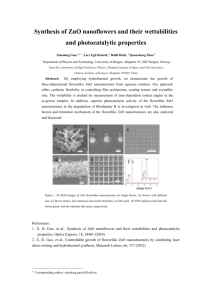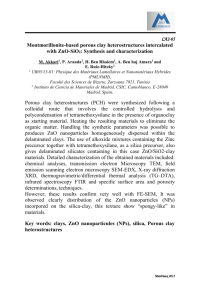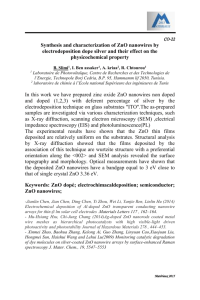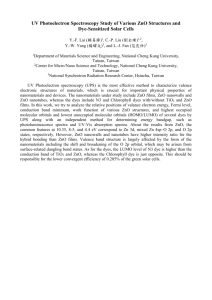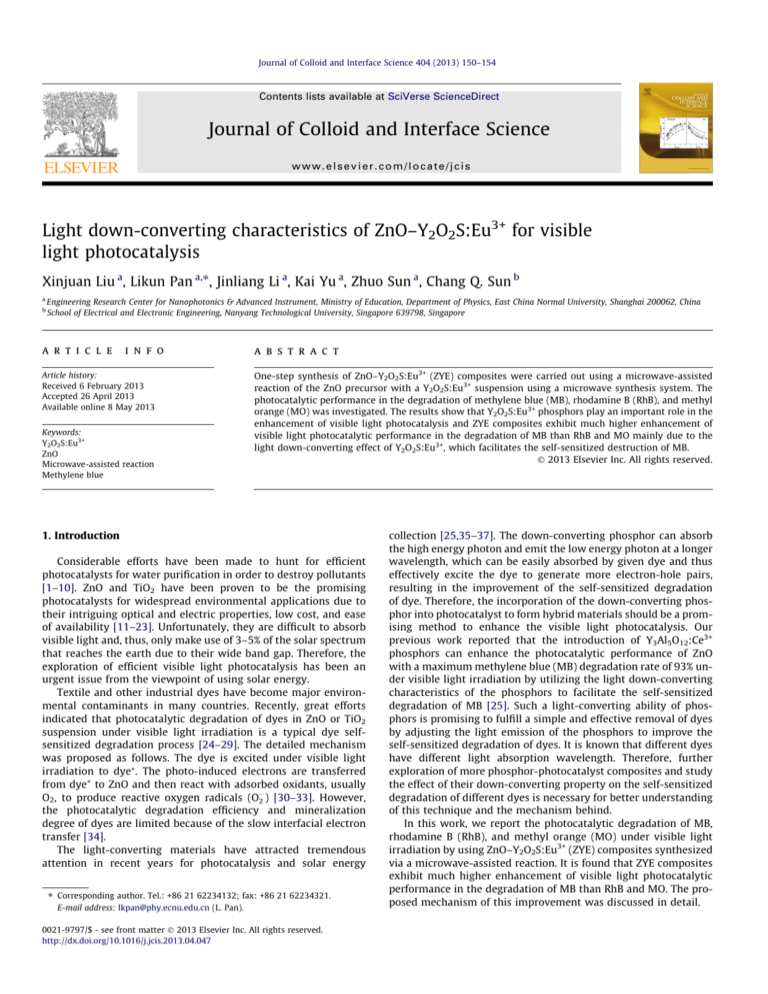
Journal of Colloid and Interface Science 404 (2013) 150–154
Contents lists available at SciVerse ScienceDirect
Journal of Colloid and Interface Science
www.elsevier.com/locate/jcis
Light down-converting characteristics of ZnO–Y2O2S:Eu3+ for visible
light photocatalysis
Xinjuan Liu a, Likun Pan a,⇑, Jinliang Li a, Kai Yu a, Zhuo Sun a, Chang Q. Sun b
a
b
Engineering Research Center for Nanophotonics & Advanced Instrument, Ministry of Education, Department of Physics, East China Normal University, Shanghai 200062, China
School of Electrical and Electronic Engineering, Nanyang Technological University, Singapore 639798, Singapore
a r t i c l e
i n f o
Article history:
Received 6 February 2013
Accepted 26 April 2013
Available online 8 May 2013
Keywords:
Y2O2S:Eu3+
ZnO
Microwave-assisted reaction
Methylene blue
a b s t r a c t
One-step synthesis of ZnO–Y2O2S:Eu3+ (ZYE) composites were carried out using a microwave-assisted
reaction of the ZnO precursor with a Y2O2S:Eu3+ suspension using a microwave synthesis system. The
photocatalytic performance in the degradation of methylene blue (MB), rhodamine B (RhB), and methyl
orange (MO) was investigated. The results show that Y2O2S:Eu3+ phosphors play an important role in the
enhancement of visible light photocatalysis and ZYE composites exhibit much higher enhancement of
visible light photocatalytic performance in the degradation of MB than RhB and MO mainly due to the
light down-converting effect of Y2O2S:Eu3+, which facilitates the self-sensitized destruction of MB.
Ó 2013 Elsevier Inc. All rights reserved.
1. Introduction
Considerable efforts have been made to hunt for efficient
photocatalysts for water purification in order to destroy pollutants
[1–10]. ZnO and TiO2 have been proven to be the promising
photocatalysts for widespread environmental applications due to
their intriguing optical and electric properties, low cost, and ease
of availability [11–23]. Unfortunately, they are difficult to absorb
visible light and, thus, only make use of 3–5% of the solar spectrum
that reaches the earth due to their wide band gap. Therefore, the
exploration of efficient visible light photocatalysis has been an
urgent issue from the viewpoint of using solar energy.
Textile and other industrial dyes have become major environmental contaminants in many countries. Recently, great efforts
indicated that photocatalytic degradation of dyes in ZnO or TiO2
suspension under visible light irradiation is a typical dye selfsensitized degradation process [24–29]. The detailed mechanism
was proposed as follows. The dye is excited under visible light
irradiation to dye⁄. The photo-induced electrons are transferred
from dye⁄ to ZnO and then react with adsorbed oxidants, usually
O2, to produce reactive oxygen radicals (O2 ) [30–33]. However,
the photocatalytic degradation efficiency and mineralization
degree of dyes are limited because of the slow interfacial electron
transfer [34].
The light-converting materials have attracted tremendous
attention in recent years for photocatalysis and solar energy
⇑ Corresponding author. Tel.: +86 21 62234132; fax: +86 21 62234321.
E-mail address: lkpan@phy.ecnu.edu.cn (L. Pan).
0021-9797/$ - see front matter Ó 2013 Elsevier Inc. All rights reserved.
http://dx.doi.org/10.1016/j.jcis.2013.04.047
collection [25,35–37]. The down-converting phosphor can absorb
the high energy photon and emit the low energy photon at a longer
wavelength, which can be easily absorbed by given dye and thus
effectively excite the dye to generate more electron-hole pairs,
resulting in the improvement of the self-sensitized degradation
of dye. Therefore, the incorporation of the down-converting phosphor into photocatalyst to form hybrid materials should be a promising method to enhance the visible light photocatalysis. Our
previous work reported that the introduction of Y3Al5O12:Ce3+
phosphors can enhance the photocatalytic performance of ZnO
with a maximum methylene blue (MB) degradation rate of 93% under visible light irradiation by utilizing the light down-converting
characteristics of the phosphors to facilitate the self-sensitized
degradation of MB [25]. Such a light-converting ability of phosphors is promising to fulfill a simple and effective removal of dyes
by adjusting the light emission of the phosphors to improve the
self-sensitized degradation of dyes. It is known that different dyes
have different light absorption wavelength. Therefore, further
exploration of more phosphor-photocatalyst composites and study
the effect of their down-converting property on the self-sensitized
degradation of different dyes is necessary for better understanding
of this technique and the mechanism behind.
In this work, we report the photocatalytic degradation of MB,
rhodamine B (RhB), and methyl orange (MO) under visible light
irradiation by using ZnO–Y2O2S:Eu3+ (ZYE) composites synthesized
via a microwave-assisted reaction. It is found that ZYE composites
exhibit much higher enhancement of visible light photocatalytic
performance in the degradation of MB than RhB and MO. The proposed mechanism of this improvement was discussed in detail.
X. Liu et al. / Journal of Colloid and Interface Science 404 (2013) 150–154
2. Experimental
2.1. Synthesis of ZnO–Y2O2S:Eu3+ composite
A certain amount of the Y2O2S:Eu3+ phosphors (2.03, 4.06, or
8.14 mg) (Shenzhen Intematix photonics Co., Ltd., China) were
added into 20 ml 0.1 M ZnSO4 solution, which was placed in a
35 ml microwave tube, and then, the solution was sonicated for
30 min to produce a uniform dispersion. A dilute NaOH solution
was dropped in the solution with a pH value of 12. The mixture
was then put into an automated focused microwave oven (Explorer-48, CEM Co.) and treated at 150 °C with a microwave irradiation power of 150 W for 10 min. The as-synthesized ZYE samples
with 0.25, 0.5, and 1 wt.% Y2O2S:Eu3+, named as ZY-0.25, ZY-0.5
and ZY-1, were isolated by filtration, washed for three times with
distilled water, and finally dried in a vacuum oven at 60 °C for
24 h. Pure ZnO was also synthesized by a direct microwave assisted
reaction for comparison. For the electrochemical impedance spectra (EIS) testing, the as-synthesized composites with 5 wt.% cellulose binder were homogenously mixed in terpineol to form a
slurry. Then, the resultant slurries were coated on the FTO using
a screen-printing approach. Finally, these prepared electrodes were
sintered at 500 °C for 30 min.
151
films as working electrodes, a Pt foil as counter electrode and a
standard calomel electrode as reference electrode. The electrolyte
was 5 mg l 1 MB aqueous solution. EIS were recorded in the frequency range of 0.1 Hz–1 M Hz, and the applied bias voltage and
ac amplitude were set at open-circuit voltage and 10 mV AC
between the counter electrode and the working electrode,
respectively.
2.3. Photocatalytic experiments
The photocatalytic performance of the as-prepared samples was
evaluated through the photocatalytic degradation of MB, RhB, and
MO under visible light irradiation. The samples (2 g l 1) were dispersed in 80 ml MB (5 mg l 1), RhB (5 mg l 1), and MO (5 mg l 1)
aqueous solutions, respectively. The mixed suspensions were first
magnetically stirred in the dark for 30 min to reach the adsorption–desorption equilibrium. Under the ambient conditions and
stirring, the mixed suspensions were exposed to visible light irradiation produced by a 400 W metal halogen lamp (wavelength:
390–800 nm). At certain time intervals, 2 ml of the mixed suspensions was extracted and centrifugated to remove the photocatalyst.
The filtrates were analyzed by recording UV–vis spectra of MB,
RhB, and MO using a Hitachi U-3900 UV–vis spectrophotometer.
2.2. Characterization
3. Results and discussion
The surface morphology, structure, and composition of the samples were characterized by field-emission scanning electron
microscopy (FESEM, Hitachi S-4800), X-ray diffraction spectroscopy (XRD, Holland Panalytical PRO PW3040/60) with Cu Ka radiation (V = 30 kV, I = 25 mA), and energy dispersive X-ray
spectroscopy (EDS, JEM-2100), respectively. UV–vis absorption
spectra were recorded using a Hitachi U-3900 UV–vis spectrophotometer. Photoluminescence (PL) spectra at room temperature
were examined by fluorescence spectrophotometer (HORIBA Jobin
Yvon fluoromax-4). EIS measurement was carried out on an electrochemical workstation (AUTOLAB PGSTAT302N) under dark conditions using a three electrode configuration with the as-prepared
Fig. 1a and b shows the FESEM images of the as-synthesized
ZnO and Y2O2S:Eu3+. ZnO displays the particle structure and Y2O2S:Eu3+ particles are monodisperse with diameters in the range of
3–5 lm. Fig. 1c and d displays the low magnification and high
magnification FESEM images of ZY-0.5. The morphologies of ZY0.25 and ZY-1 (not shown here) are similar to that of ZY-0.5. It is
seen that the Y2O2S:Eu3+ is surrounded by the ZnO particles in
the composite. The morphology of ZnO in the ZYE composite is
similar to that of the pure ZnO, as shown in the Fig. 1d, which indicates that the introduction of Y2O2S:Eu3+ does not affect the formation of ZnO. Furthermore, the existence of ZnO and Y2O2S:Eu3+ in
Fig. 1. FESEM images of: (a) ZnO, (b) Y2O2S:Eu3+, (c) low magnification, and (d) high magnification images of ZY-0.5.
152
X. Liu et al. / Journal of Colloid and Interface Science 404 (2013) 150–154
the composite has been confirmed by the peaks of Zn, O, Y, S, and
Eu in EDS data, as shown in Fig. 2.
The XRD patterns of Y2O2S:Eu3+, ZnO, and ZY-0.5 are shown in
Fig. 3a–c, respectively. The diffraction pattern of Y2O2S:Eu3+ particles shows that all the peaks can be indexed as the Y2O2S phase
(JPCDS 24-1424) and no other crystalline phase presents. The main
diffraction peaks of ZY-0.5 are similar to those of pure ZnO and correspond to wurtzite-structured ZnO (JPCDS 36-1451), which demonstrates that the presence of Y2O2S:Eu3+ does not result in the
development of new crystal orientations or changes in preferential
orientations of ZnO. Compared with pure ZnO, the peaks corresponding to the hexagonal crystal structure of Y2O2S:Eu3+ appear
in XRD pattern of ZY-0.5, which further confirms the existence of
Y2O2S:Eu3+ in the composite.
The UV–vis absorption spectra of ZnO, ZY-0.25, ZY-0.5, and ZY-1
are shown in Fig. 4. The sharp characteristic absorption peak at
370 nm is dominated by ZnO. The ZYE composites exhibit higher
absorbance in the visible light region and the intensity increases
with the increase in Y2O2S:Eu3+ content. The result is similar to
that in the case of other composite materials [38,39]. Such an
enhancement of light absorption is beneficial to generate more
photo-generated electrons and holes.
Fig. 5a shows the PL emission spectrum of Y2O2S:Eu3+ under
excitation at 400 nm. The strong red-emission peaks at 624 nm
and 615 nm are observed due to the transition from 5d0 ? 7f2 levels. In the orange-emission lines, the peaks at 580 nm and 593 nm
are apparent, which are produced by the electron transition from
5d0 ? 7f0 and 5d0 ? 7f1 levels. All results are in agreement with
those reported in previous works [40,41]. The luminescence at
these wavelengths falls in the absorption range of the dye sensitizer MB (<663 nm), but it cannot be absorbed by the MO
Fig. 2. EDS spectrum of ZY-0.5.
Fig. 3. XRD patterns of: (a) Y2O2S:Eu3+, (b) ZnO, and (c) ZY-0.5.
Fig. 4. UV–vis absorption spectra of ZnO, ZY-0.25, ZY-0.5, and ZY-1.
(<463 nm) and RhB (<553 nm). The result indicates that Y2O2S:Eu3+
can absorb the high energy photon well and emit the visible light
at a long wavelength which matches the absorption range of MB.
Fig. 5b displays the PL emission spectra of ZnO, ZY-0.25, ZY-0.5,
and ZY-1 under excitation at 400 nm. Compared with pure ZnO,
the peaks at 615 nm and 624 nm appear in the PL spectra of
ZY-0.25, ZY-0.5 and ZY-1, which further confirms the existence of
Y2O2S:Eu3+ in the composites. The lower PL intensities of ZnO in
ZY-0.25, ZY-0.5, and ZY-1 indicate that the recombination of
photo-induced electrons and holes should be effectively inhibited
in the composites compared with pure ZnO [38].
The charge transfer and recombination behavior of as-prepared
samples was further studied by analyzing the EIS spectra at opencircuit voltage in dark conditions. Fig. 6 shows the typical Nyquist
plots of ZnO, ZY-0.25, ZY-0.5, and ZY-1. The semicircle in the EIS
spectra is due to the contribution from the charge-transfer impedance (Rct) and constant phase element (CPE) at the photocatalyst/
electrolyte interface. The inclined line, resulting from the Warburg
impedance ZW, corresponds to the ion-diffusion process in the
electrolyte. The corresponding equivalent circuit is shown in the
inset of Fig. 6. It can be observed that the Rct decreases with the increase in Y2O2S:Eu3+ content, which indicates that the introduction
of Y2O2S:Eu3+ in ZnO favors the electron transfer and suppresses
charge recombination in ZnO [35], which can enhance the photocatalytic performance. However, when the Y2O2S:Eu3+ content is
further increased, the Rct increases, which is possibly because that
excessive Y2O2S:Eu3+ can act as recombination center and promote
the recombination of electron-hole pairs in Y2O2S:Eu3+.
Photocatalytic degradation of MB by ZnO, ZY-0.25, ZY-0.5, and
ZY-1 was performed under visible light irradiation. Fig. 7 shows
the UV–vis absorbance of MB at the varied irradiation time under
visible light irradiation using ZY-0.5. It is observed that the UV–
vis absorption peak of MB, related to the concentration of MB in
the solution, becomes weak with the increase in the irradiation
time. Fig. 8 displays the time-dependent degradation rates of MB
by ZnO, ZY-0.25, ZY-0.5, and ZY-1 under visible light irradiation.
The normalized temporal concentration changes (C/C0) of MB during the photocatalytic process are proportional to the normalized
maximum absorbance (A/A0), which can be derived from the
change in the MB absorption profile at a given time interval. It is
observed that the concentration of MB is hardly reduced under visible light irradiation in the absence of the photocatalyst. ZYE composites exhibit better photocatalytic performance than pure ZnO
and the photocatalytic performance of ZYE composites is dependent on the Y2O2S:Eu3+ content. The degradation rate of MB for
pure ZnO is only 13%. When Y2O2S:Eu3+ is introduced, the degradation rate is increased to 61% for ZY-0.25 and reaches a maximum
value of 95% for ZY-0.5 at 240 min. This enhancement should be
X. Liu et al. / Journal of Colloid and Interface Science 404 (2013) 150–154
153
Fig. 5. PL emission spectra of: (a) Y2O2S:Eu3+ and (b) ZnO, ZY-0.25, ZY-0.5, and ZY-1.
Fig. 6. Nyquist plots of ZnO, ZY-0.25, ZY-0.5, and ZY-1. Inset is the corresponding
equivalent circuit model.
Fig. 7. UV–vis absorbance of MB with the variation of irradiation time under visible
light irradiation using ZY-0.5.
ascribed to the increase in visible light absorption and the
reduction of the electron-hole pair recombination in ZnO with
the introduction of Y2O2S:Eu3+. However, the self-sensitized degradation of the dyes should play a critical role in the improvement of
photocatalytic performance under visible light irradiation
[24,25,30]. When Y2O2S:Eu3+ phosphors are doped into ZnO, they
can absorb the high energy photon well and emit the visible light
at a long wavelength. These low energy photons can be easily absorbed by the MB and thus effectively excite the MB to generate
more electron-hole pairs, which results in the obvious improvement of the self-sensitized degradation of MB and enhances the
photocatalytic performance. However, when the Y2O2S:Eu3+ content is further increased, the photocatalytic rate decreases. This
deterioration should be due to the following possible reasons: (i)
Fig. 8. Photocatalytic degradation of MB by ZnO, ZY-0.25, ZY-0.5, and ZY-1 under
visible light irradiation.
Fig. 9. Photocatalytic reaction kinetics of MB with the variation of reaction time.
excessive Y2O2S:Eu3+ can cover the active sites on the surface of
ZnO to decrease the amount of absorbed MB on the surface of
ZnO [42]; (ii) more Y2O2S:Eu3+ can act as a kind of recombination
center and promote the recombination of electron-hole pairs in
Y2O2S:Eu3+[25].
Fig. 9 shows the linear fitting between pseudo-first-order kinetic equation and experimental data for ZnO, ZY-0.25, ZY-0.5,
and ZY-1. The values of rate constants (k) can be obtained directly
from the fitted straight-line plots of ln(Ci/C0) versus reaction time.
The value of k in the absence of the photocatalyst is 0.0002 min 1,
indicating that MB can almost not be reduced in the dark reaction.
When photocatalysts are used, the values of k under visible light
irradiation follow the order: ZY-0.5 (0.0132 min 1) > ZY-1
(0.0034 min 1) > ZY-0.25 (0.0032 min 1) > ZnO (0.0005 min 1).
The result shows that ZY-0.5 exhibits a best photocatalytic activity
under visible light irradiation.
154
X. Liu et al. / Journal of Colloid and Interface Science 404 (2013) 150–154
of MB, RhB, and MO by ZYE composite is mainly due to the obvious
improvement of the self-sensitized degradation of MB.
Acknowledgments
Financial support from Scholarship Award for Excellent Doctoral Student Granted by Ministry of Education (No.
MXRZZ2012006) is gratefully acknowledged.
References
Fig. 10. Photocatalytic degradation of RhB by ZnO and ZY-0.5 under visible light
irradiation.
[1]
[2]
[3]
[4]
[5]
[6]
[7]
[8]
[9]
[10]
[11]
[12]
[13]
[14]
[15]
[16]
[17]
[18]
[19]
[20]
[21]
Fig. 11. Photocatalytic degradation of MO by ZnO and ZY-0.5 under visible light
irradiation.
[22]
[23]
The photocatalytic degradation of RhB and MO by ZnO and ZY0.5 was performed under visible light irradiation for comparison,
as shown in Fig. 10 and 11. The degradation rate of RhB is increased
from 70% for ZnO to 88% for ZY-0.5 and the degradation rate of MO
from 12% for ZnO to 23% for ZY-0.5, respectively. The high degradation rate of RhB by pure ZnO is due to good self-sensitized degradation of RhB [43–45]. However, only small enhancement is
observed in the degradation of RhB and MO when the Y2O2S:Eu3+
is introduced into ZnO, which should be ascribed to the increase
in visible light absorption and the reduction of the electron-hole
pair recombination in ZnO. Because the low energy photons emitted by Y2O2S:Eu3+ phosphors cannot be absorbed by the RhB and
MO, the self-sensitized degradation is not obviously enhanced in
the degradation of RhB and MO. Therefore, a large difference in
the photocatalytic degradation of MB, RhB, and MO by ZYE composite is observed.
4. Conclusions
In summary, we successfully synthesized the ZYE composites
via a microwave-assisted reaction of the ZnO precursor with a Y2O2S:Eu3+ suspension using a microwave system for visible light
photocatalysis. The results indicate that (i) ZYE composites exhibit
a better visible light photocatalytic performance than pure ZnO;
(ii) the photocatalytic performance of ZYE is dependent on the proportion of Y2O2S:Eu3+ in the composites and the ZYE composite
with 0.5 wt.% Y2O2S:Eu3+ achieves a highest MB degradation rate
of 95%; (iii) the enhancement of visible light photocatalytic degradation of MB is much higher than those for the degradation of RhB
and MO; (iv) the large difference in the photocatalytic degradation
[24]
[25]
[26]
[27]
[28]
[29]
[30]
[31]
[32]
[33]
[34]
[35]
[36]
[37]
[38]
[39]
[40]
[41]
[42]
[43]
[44]
[45]
Q.J. Xiang, J.G. Yu, M. Jaroniec, Chem. Soc. Rev. 41 (2012) 782–796.
B.J. Li, H.Q. Cao, J. Mater. Chem. 21 (2011) 3346–3349.
G.C. Xi, J.H. Ye, Chem. Commun. 46 (2010) 1893–1895.
S.C. Yan, L.J. Wan, Z.S. Li, Z.G. Zou, Chem. Commun. 47 (2011) 5632–5634.
J. Jiang, L. Zhang, Chem.-A Eur. J. 17 (2011) 3710–3717.
W. Wu, S.F. Zhang, J. Zhou, X.H. Xiao, F. Ren, C.Z. Jiang, Chem.-A Eur. J. 17
(2011) 9708–9719.
C. Hu, T.W. Peng, X.X. Hu, Y.L. Nie, X.F. Zhou, J.H. Qu, H. He, J. Am. Chem. Soc.
132 (2009) 857–862.
X.J. Liu, L.K. Pan, T. Lv, G. Zhu, Z. Sun, C.Q. Sun, Chem. Commun. 47 (2011)
(1986) 11984–11986.
Y.H. Zhang, N. Zhang, Z.R. Tang, Y.J. Xu, ACS Nano 6 (2012) 9777–9789.
W.Q. Cui, Y.F. Liu, L. Liu, J.S. Hu, Y.H. Liang, Appl. Catal. A: Gen. 417–418 (2012)
111–118.
J.B. Joo, Q. Zhang, M. Dahl, I. Lee, J. Goebl, F. Zaera, Y.D. Yin, Energy Environ. Sci.
5 (2012) 6321–6327.
M.Y. Xing, Y.M. Wu, J.L. Zhang, F. Chen, Nanoscale 2 (2010) 1233–1239.
P.F. Fu, P.Y. Zhang, Appl. Catal. B: Environ. 96 (2010) 176–184.
Q. Shen, W. Zhang, Z.P. Hao, L.D. Zou, Chem. Eng. J. 165 (2010) 301–309.
F.Y. Shen, W.X. Que, Y.L. Liao, X.T. Yin, Ind. Eng. Chem. Res. 50 (2011) 9131–
9137.
Y.H. Zhang, Z.R. Tang, X.Z. Fu, Y.J. Xu, ACS Nano 2 (2010) 7303–7314.
K.F. Zhou, Y.H. Zhu, X.L. Yang, X. Jiang, C.Z. Li, New J. Chem. 35 (2011) 353–359.
M.Y. Zhang, C.L. Shao, J.B. Mu, Z.Y. Zhang, Z.C. Guo, P. Zhang, Y.C. Liu,
CrystEngComm 14 (2012) 605–612.
J.X. Xu, W.X. Wang, S.M. Sun, L. Wang, Appl. Catal. B: Environ. 111–112 (2012)
126–132.
S. Furukawa, T. Shishido, K. Teramura, T. Tanaka, ACS Catal. 2 (2012) 175–179.
Y. Cong, X.K. Li, Y. Qin, Z.J. Dong, G.M. Yuan, Z.W. Cui, X.J. Lai, Appl. Catal. A:
Gen. 107 (2011) 128–134.
K. Hayat, M.A. Gondal, M.M. Khaled, S. Ahmed, A.M. Shemsi, Appl. Catal. A:
Gen. 393 (2011) 122–129.
C.Z. Li, J.Y. Zhang, J.A. Yang, T.M. Wang, X. Lv, Z.L. Tang, Appl. Catal. A: Gen. 402
(2011) 80–86.
Z.G. Xiong, L.L. Zhang, J.Z. Ma, X.S. Zhao, Chem. Commun. 46 (2010) 6099–
6101.
X.J. Liu, X.J. Wang, H.L. Li, L.K. Pan, T. Lv, Z. Sun, C.Q. Sun, J. Mater. Chem. 22
(2012) 16293–16298.
F. Han, V.S.R. Kambala, M. Srinivasan, D. Rajarathnam, R. Naidu, Appl. Catal. B:
Environ. 359 (2009) 25–40.
P.F. Ji, J.L. Zhang, F. Chen, M. Anpo, Appl. Catal. B: Environ. 85 (2009) 148–154.
L. Pan, J.J. Zou, X.Y. Liu, X.J. Liu, S.B. Wang, X.W. Zhang, L. Wang, Ind. Eng. Chem.
Res. 51 (2012) 12782–12786.
Y. Yan, H.P. Sun, P.P. Yao, S.Z. Kang, J. Mu, Appl. Surf. Sci. 257 (2011) 3620–3626.
T. Lv, L.K. Pan, X.J. Liu, T. Lu, G. Zhu, Z. Sun, C.Q. Sun, Catal. Sci. Technol. 2
(2012) 754–758.
B. O’Regan, M. Grfitzeli, Nature 353 (1991) 737–739.
S. Cho, J.W. Jang, S. Hwang, J.S. Lee, S.H. Kim, Langmuir 28 (2012) 17530–
17536.
C.C. Chen, W.H. Ma, J.C. Zhao, Chem. Soc. Rev. 39 (2010) 4206–4219.
S.B. Zhu, T.G. Xu, H.B. Fu, J.C. Zhao, Y.F. Zhu, Environ. Sci. Technol. 41 (2007)
6234–6239.
G. Zhu, X.J. Wang, H.L. Li, L.K. Pan, H.C. Sun, X.J. Liu, T. Lv, Z. Sun, Chem.
Commun. 48 (2012) 958–960.
L.N. Yin, J.Q. Gao, J. Wang, X.Y. Luan, P.L. Kang, Y. Li, K. Li, X.D. Zhang, Res.
Chem. Intermed. 38 (2012) 523–536.
J. Wang, R.H. Li, Z.H. Zhang, W. Sun, R. Xu, Y.P. Xie, Z.Q. Xing, X.D. Zhang, Appl.
Catal. A: Gen. 334 (2008) 227–233.
X.D. Jiang, Y.Q. Wang, C.X. Pan, J. Alloys Compd. 509 (2011) L137–L141.
Z.J. Zhang, W.Z. Wang, J. Xu, M. Shang, J. Ren, S.M. Sun, Catal. Commun. 13
(2011) 31–34.
C.F. Guo, L. Luan, C.H. Chen, D.X. Huang, Q. Su, Mater. Lett. 62 (2008) 600–602.
T.W. Chou, S. Mylswamy, R.S. Liu, S.Z. Chuang, Solid State Commun. 136 (2005)
205–209.
J.Q. Gao, X.Y. Luan, J. Wang, B.X. Wang, K. Li, Y. Li, P.L. Kang, G.X. Han,
Desalination 268 (2011) 68–75.
G.Q. Li, N. Yang, X.L. Yang, W.L. Wang, W.F. Zhang, J. Phys. Chem. C 115 (2011)
13734–13738.
N. Yang, G.Q. Li, X.L. Yang, W.L. Wang, W.F. Zhang, Dalton Trans. 40 (2011)
3459–3461.
D.H. Wang, G.Q. Gao, Y.W. Zhang, L.S. Zhou, A.W. Xu, W. Chen, Nanoscale 2
(2012) 7780–7785.




